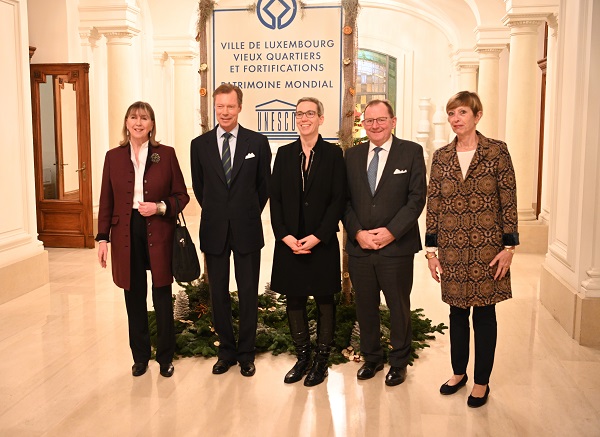 Credit: MCULT
Credit: MCULT
On Tuesday, Luxembourg's Minister of Culture, Sam Tanson, the Mayor of the City of Luxembourg, Lydie Polfer, and the President of the Luxembourg Commission for Cooperation with UNESCO, Simone Beck, welcomed His Royal Highness the Grand Duke at Cercle Cité for an academic session organised as part of Luxembourg City's 25th World Heritage Anniversary.
In her opening speech, Lydie Polfer recalled the inclusion on 17 December 1994 of the "City of Luxembourg: its Old Quarters and Fortifications" in the World Heritage Register: "The recognition of the exceptional universal value of our site has a fourfold effect on the City of Luxembourg: the historical and landscape heritage is protected at international, national and local levels, its enhancement strengthens the tourist appeal of the destination, increases the quality of life for residents, raises awareness of the site's identity".
The Director of the Heritage Division and the UNESCO World Heritage Centre, Mechtild Rössler, had relayed this message, confirming that UNESCO appreciated regular consultation with the World Heritage Centre and the International Council on Monuments and Sites (ICOMOS) for large-scale projects in Luxembourg.
In her speech, Simone Beck underlined the importance of this global organisation in a world that always presents new challenges. She noted the merits of all the people who spared no effort to prepare the application file for the "City of Luxembourg: its Old Quarters and Fortifications" for the prestigious World Heritage programme.
Sam Tanson maintained that only the government's commitment as a member of the United Nations made it possible to submit a nomination to the World Heritage Centre in 1993; the country received a positive answer on the eve of the cultural year 1995. The Culture Minister commented: "World recognition had placed the "City of Luxembourg: its Old Quarters and Fortifications" on the world map of culture. It was a kick-off for the creation of many cultural infrastructures, including the Lëtzebuerg City Museum, the Philharmonie, the MUDAM or neimënster, and to set up an ambitious programme of heritage restoration and animation of the old town and fortifications. I congratulate the many actors whose projects have been labelled as part of the anniversary programme and who stand out not only for their innovative nature, but also for their commitment to education in dialogue for peace, digital communication, sustainable development".
Professor Dr Carola Neugebauer of the Faculty of Architecture of the RWTH in Aachen enriched this academic session with a conference entitled "Stadtentwicklung durch Inwertsetzung des UNESCO-Weltkulturerbestatus", which will soon be available on www.unesco.lu. UNESCO Site Manager, Robert L. Philippart, closed the session by recalling the United Nations 2030 Agenda for Sustainable Cities.
Musical accompaniment was provided by the Voices International choir, bringing together 45 adults from 25 different countries. Similarly, UNESCO Artist for Peace, Naseer Shamma, played the Iraqi oud, the sounds of which evoked the musician's commitment to the “globalisation of this art” and his fight for peace and access to all to culture.
The "25 ans Lëtzebuerg patrimoine mondial" programme is available online at www.patrimoinemondial.lu.









